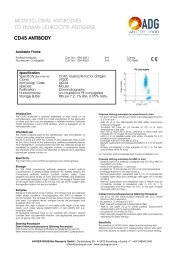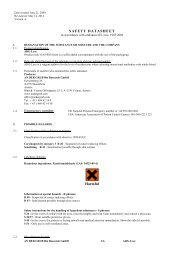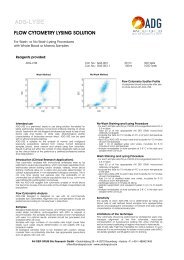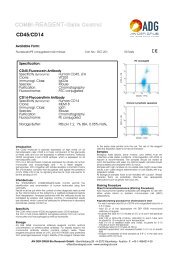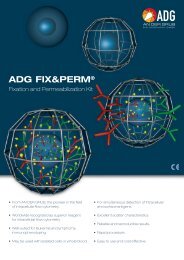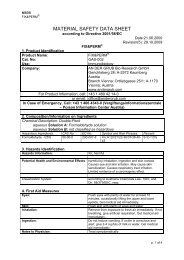Pdf-download - AN DER GRUB Bio Research Gmbh
Pdf-download - AN DER GRUB Bio Research Gmbh
Pdf-download - AN DER GRUB Bio Research Gmbh
You also want an ePaper? Increase the reach of your titles
YUMPU automatically turns print PDFs into web optimized ePapers that Google loves.
MONOCLONAL <strong>AN</strong>TIBODIES<br />
TO HUM<strong>AN</strong> LEUKOCYTE <strong>AN</strong>TIGENS<br />
Lactoferrin <strong>AN</strong>TIBODY<br />
Available Forms:<br />
Purified Antibody Cat. No.: GM-4111 2ml 0,2mg<br />
Phycoerythrin Conjugate Cat. No.: GM-4113 2ml 100 Tests<br />
Specification<br />
Specificity (Synonyms): Lactoferrin<br />
Clone: 4C5<br />
Immunogl. Class: IgG1<br />
Species: Mouse<br />
Purification: Chromatography<br />
Fluorochrome: un-coupled or PE conjugated<br />
Storage Buffer: PBS pH 7.2, 1% BSA, 0.05% NaN 3<br />
Introduction<br />
Lactoferrin (LF) is an iron-binding protein with bactericidal and<br />
bacteriostatic activity, which is stored within the secondary granules<br />
of granulocytes. LF expression is restricted to the post-mitotic<br />
maturation compartment of the granulocytic lineage, starting from<br />
the myelocyte stage. Normal and malignant myeloblasts are LF<br />
negative.<br />
Intended use<br />
The 4C5 antibody permits the identification and enumeration of<br />
human granulocytes using flow cytometry.<br />
Results must be put within the context of other diagnostic tests as well<br />
as the clinical history of the patient by a certified professional before<br />
final interpretation. Analyses performed with this antibody should be<br />
paralleled by positive and negative controls. If unexpected results<br />
are obtained which cannot be attributed to differences in laboratory<br />
procedures, please contact us.<br />
Specificity<br />
The LF mAb (clone 4C5) recognizes Lactoferrin stored within<br />
secondary granules of postmitotic granulocyte-committed cells.<br />
Storage<br />
<strong>AN</strong> <strong>DER</strong> <strong>GRUB</strong> monoclonal antibody reagents contain optimal<br />
concentrations of affinity-purified antibody. For stability reasons this<br />
monoclonal antibody solution contains sodium azide. These<br />
reagents should be stored at 2-8°C (DO NOT FREEZE!) and protected<br />
from prolonged exposure to light. Stability of the reagent: Please refer<br />
to the expiry date printed onto the vial. The use of the reagent after<br />
the expiration date is not recommended.<br />
Samples<br />
<strong>Bio</strong>logical fluids (blood, bone marrow, and others) must be collected<br />
under sterile conditions. Anticoagulation with EDTA or heparin is<br />
recommended. The samples should be stored at room temperature<br />
until used. For optimal results, samples should be processed and<br />
analyzed within 24 hours.<br />
Samples with high numbers of non-viable cells might cause false<br />
results, such cases require determination of cell viability with e.g.<br />
propidium iodide.<br />
All biological samples have to be handled with caution. Always<br />
consider them as potentially infective. Use appropriate precautions<br />
such as gloves, lab-coat, etc.<br />
Staining Procedure:<br />
Permeabilization and Staining Procedure<br />
- In combination with our Permeabilization Kit FIX&PERM ® (Cat. No.<br />
PB: Leukogate<br />
LF - FITC<br />
GAS-002) intracellular Lactoferrin can be easily stained in cell<br />
suspensions.<br />
- For each sample to be analyzed add 50 µl of whole blood,<br />
bone marrow or mononuclear cell suspension in a 5ml tube<br />
- Add 100 µl of Reagent A (Fixation Medium, stored and used at<br />
room temperature)<br />
- Incubate for 15 minutes at room temperature<br />
- Add 5ml phosphate buffered saline and centrifuge cells for 5<br />
minutes at 300 g<br />
- Remove supernatant and add to cell pellet 100 µl Reagent B<br />
(Permeabilization Medium) and 20 µl of the Lactoferrin<br />
monoclonal antibody conjugate<br />
- Vortex at low speed for 1-2 seconds<br />
- Incubate for 15 minutes at room temperature<br />
- Wash cells with phosphate buffered saline as described above<br />
- Remove supernatant and resuspend cells in sheath fluid for<br />
immediate analysis or resuspend cells in 0.5 ml 1.0 %<br />
formaldehyde and store them at 2-8°C in the dark. Analyze fixed<br />
cells within 24 hours.<br />
Conventional Staining for Microscopic Evaluations<br />
LF-Antibody 4C5 can also be used to demonstrate lactoferrin<br />
molecules by conventional immunofluorescence or<br />
immunoenzyme staining techniques on cell smears, cytospin<br />
preparations or tissue sections. Acetone or paraformaldehyde<br />
are suitable fixatives for these purposes.<br />
Sensitivity<br />
The sensitivity of 4C5 mAb is determined by staining well-defined<br />
blood samples from representative donors with serial-fold mAb<br />
dilutions to obtain a titration curve that allows relating the mAb<br />
concentration to the percentage of stained cells and geometric<br />
MFI (mean fluorescence intensity). For this purpose, a mAbconcentration<br />
range is selected to include both the saturation<br />
point (i.e. the mAb dilution expected to bind all epitopes on the<br />
target cell) and the detection threshold (i.e. the mAb dilution<br />
expected to represent the least amount of mAb needed to<br />
detect an identical percentage of cells). In practice, 50 µl of<br />
leukocytes containing 10 7 cells/ml are stained with 20 µl mAb of<br />
various dilutions to obtain a titration curve and to identify the<br />
saturation point and detection threshold. The final concentration<br />
of the product is then adjusted to be at least 3-fold above the<br />
detection threshold. In addition and to control lot-to-lot variation,<br />
the given lot is compared and adjusted to fluorescence<br />
standards with defined intensity.<br />
<strong>AN</strong> <strong>DER</strong> <strong>GRUB</strong> <strong>Bio</strong> <strong>Research</strong> GmbH • Gerichtsberg 28 • A-2572 Kaumberg • Austria • F: +43-1-489421450<br />
office@andergrub.com • www.andergrub.com<br />
side scatter
Limitations of the technique<br />
Flow cytometry should be performed by professional users only.<br />
Improper alignment of the flow cytometer, inaccurate<br />
compensation of fluorescence leaking into other channels as well as<br />
incorrect positioning of regions may lead to false results.<br />
Lysis of red cells might be impossible for various reasons. In such<br />
instances it is recommended to isolate mononuclear cells (MNC) via<br />
density gradient centrifugation prior to staining.<br />
Results will be correct and reproducible as long as the procedures<br />
used respect the technical recommendations and obey good<br />
laboratory practice.<br />
The antibody is provided in a concentration that will allow to<br />
unequivocally detect specific cells. It is therefore strongly<br />
recommended to stick to the staining protocol in terms of<br />
concentration and volume regarding cells and antibody.<br />
The therapeutic use of antibodies might influence the recognition of<br />
target-antigens by this antibody. The reaction pattern of 4C5 mAb<br />
alone is not sufficient to diagnose “leukemia”. Combination with<br />
other antibodies in multi-color stainings is strongly recommended.<br />
The properties of this mAb have been determined using EDTA anticoagulated<br />
peripheral blood.<br />
Precautions<br />
For professional users only.<br />
This reagent contains sodium azide. To avoid the development of<br />
hazardous conditions, reagents containing azide should be diluted in<br />
running water prior to be discarded. Similar to the work with other<br />
biological products, proper handling procedures are<br />
recommended.<br />
Warranty<br />
The products sold hereunder are warranted only to conform to the<br />
quantity and contents stated on the label at the time of delivery to<br />
the customer. There are no warranties, expressed or implied, that<br />
extend beyond the description on the label of the product. ADG´s<br />
sole liability is limited to either replacement of the products or<br />
refund of the purchase price. ADG is not liable for property<br />
damage, personal injury, or economic loss caused by the<br />
product.<br />
Selected References<br />
Braylan, R. C., Orfao, A., Borowitz, M. J. & Davis, B. H. (2001)<br />
Cytometry 46, 23-7.<br />
Catovsky, D., Matutes, E., Buccheri, V., Shetty, V., Hanslip, J.,<br />
Yoshida, N. & Morilla, R. (1991) Ann Hematol 62, 16-21.<br />
Cowland, J. B. & Borregaard, N. (1999) J Leukoc <strong>Bio</strong>l 66, 989-95.<br />
Cramer, E., Pryzwansky, K. B., Villeval, J. L., Testa, U. & Breton-<br />
Gorius, J. (1985) Blood 65, 423-32.<br />
Groeneveld, K., te Marvelde, J. G., van den Beemd, M. W.,<br />
Hooijkaas, H. & van Dongen, J. J. (1996) Leukemia 10, 1383-9.<br />
Gullberg, U., Andersson, E., Garwicz, D., Lindmark, A. & Olsson, I.<br />
(1997) Eur J Haematol 58, 137-53.<br />
He, J. & Furmanski, P. (1995) Nature 373, 721-4.<br />
Knapp, W., Majdic, O. & Strobl, H. (1993) Recent Results Cancer<br />
Res 131, 31-40.<br />
Konikova, E., Glasova, M., Kusenda, J. & Babusikova, O. (1998)<br />
Neoplasma 45, 282-91.<br />
Oehler, L., Majdic, O., Pickl, W. F., Stockl, J., Riedl, E., Drach, J.,<br />
Rappersberger, K., Geissler, K. & Knapp, W. (1998) J Exp Med<br />
187, 1019-28.<br />
Paietta, E. (2003) Best Pract Res Clin Haematol 16, 671-83.<br />
Rado, T. A., Bollekens, J., St Laurent, G., Parker, L. & Benz, E. J., Jr.<br />
(1984) Blood 64, 1103-9.<br />
Rado, T. A., Wei, X. P. & Benz, E. J., Jr. (1987) Blood 70, 989-93.<br />
Srivastava, C. H., Rado, T. A., Bauerle, D. & Broxmeyer, H. E.<br />
(1991) J Immunol 146, 1014-9.<br />
Strobl, H. & Knapp, W. (2004) J <strong>Bio</strong>l Regul Homeost Agents 18,<br />
335-9.<br />
Teng, C. T., Gladwell, W., Beard, C., Walmer, D., Teng, C. S. &<br />
Brenner, R. (2002) Mol Hum Reprod 8, 58-67.<br />
FOR RESEARCH USE ONLY! NOT FOR DIAGNOSTIC OR THERAPEUTIC USE!<br />
<strong>AN</strong> <strong>DER</strong> <strong>GRUB</strong> <strong>Bio</strong> <strong>Research</strong> GmbH • Gerichtsberg 28 • A-2572 Kaumberg • Austria • F: +43-1-489421450<br />
office@andergrub.com • www.andergrub.com



